Physical Address
304 North Cardinal St.
Dorchester Center, MA 02124
Injuries to the acromioclavicular (AC) joint are common occurrences in the athletic patient population, with approximately 9% of all shoulder injuries involving the AC joint. Injuries to the sternoclavicular (SC) joint are less common, accounting for up to 3% of all shoulder girdle injuries. Damage to either of these joints can lead to significant limitations and pain; therefore it is critical for the orthopedic surgeon to recognize and treat these conditions. Studies have reported that most AC joint injuries occur in young males and that injuries are often incomplete rather than complete. Although SC injuries are rare, disruptions to this joint can involve the critical airway and vascular structures immediately deep to the sternum, ultimately resulting in life-threatening complications.
Like other major joints, the AC joint is composed of its own joint capsule that contains an intra-articular meniscus-like structure. Eventually, the meniscus-like structure undergoes age-related degeneration and reportedly no function beyond the fourth decade of life. Articular cartilage lines both aspects of the articulation; however, the true articular portion of the distal clavicle varies with regard to location and size. In addition to the primary structures of the joint, the AC joint depends on a coordinated function of the AC, coracoclavicular (CC), and coracoacromial (CA) ligaments ( Table 56.1 ). The AC ligament acts as the primary restraint to anterior and posterior displacement of the AC joint. The CC ligament is uniquely composed of the trapezoid and conoid ligaments. The two major functions of the CC ligament include mediating synchronous scapulohumeral motion by attaching the clavicle to the scapula and providing additional strength to the AC articulation. As a result, the CC ligament mainly contributes to vertical stability by preventing superior and inferior translation of the clavicle. Although it is not a primary stabilizer, the CA ligament provides secondary glenohumeral stabilization to prevent anterosuperior displacement of the humeral head in long-standing massive rotator cuff disease. Of note, the normal anatomic CC interspace is approximately 1.1 to 1.3 cm ( Figs. 56.1–56.3 ).
| Ligament | Origin | Attachment | Function | Notes |
|---|---|---|---|---|
| Acromioclavicular: superior, posterior, anterior | Anteromedial edge of the acromion | Lateral aspect of the clavicle | Provides horizontal stability | Flattened tissue that joins the superior surface of the acromioclavicular joint capsule |
| Trapezoid (coracoclavicular) | Upper coracoid process | Oblique ridge on the inferior clavicle | Provides vertical stability (less than a conoid ligament) | Broad, thin, and quadrilateral; lateral to conoid |
| Conoid (coracoclavicular) | Base of the coracoid process | Conoid tubercle on the inferior clavicle | Provides vertical stability (more than a trapezoid ligament) | Dense and conical; medial to trapezoid |
| Coracoacromial | Lateral border of the coracoid | Anterior and inferior surface of the acromion just anterior to the clavicular articular surface | Forms part of the coracoacromial arch, preventing superior migration of the humeral head | Strong, dense, triangular band |
During normal shoulder forward elevation and abduction to 180 degrees, approximately 5 to 8 degrees of motion is detected at the AC joint. The clavicle rotates between 40 and 50 degrees during full overhead elevation. This motion is combined with scapular rotation as opposed to occurring through the AC joint itself. This synchronous motion between the clavicle—which is rotating upward as the scapula rotates downward during abduction—and forward elevation was described by Codman as synchronous scapular-clavicular rotation, which is coordinated by the CC ligaments. The motion of the AC joint is important to understand clinically, because the contribution of different ligaments with regard to resisting translation changes depends on the amount of displacement. For example, with small displacements, the AC ligaments are most important in preventing posterior and superior translation of the clavicle; however, with larger amounts of displacement, the conoid ligament becomes the primary restraint to superior translation. The trapezoid ligament is vital in resisting compression at both small and large amounts of displacement ( Fig. 56.4 ).
The pathologic process of AC joint dislocations involves sequential injury, beginning with the AC ligaments, extending to the CC ligaments, and finally affecting the deltoid and trapezial muscles and fascia. In 1963, Tossy and colleagues originally developed a classification scheme that included types I, II, and III. In 1984, Rockwood expanded the classification, which is purely radiographic, to include types IV, V, and VI ( Fig. 56.5 ). The Rockwood system is generally described as follows: In a type I injury, there is a sprain of the AC ligament with no radiographic abnormality. In type II injuries, the AC ligaments and joint capsule are disrupted, while the CC ligaments are sprained but intact, in addition to a 50% vertical subluxation of the distal clavicle. In type III injuries, the AC ligaments and joint capsule, as well as the CC ligaments, are disrupted with 100% superior displacement of the distal clavicle. In type IV injuries, there is posterior subluxation of the clavicle into the trapezius. A type V injury is an exaggeration of a type III injury with 100% to 300% superior displacement of the clavicle. In the rare type VI injury, there is subacromial or subcoracoid displacement of the clavicle and a reversed CC interspace.
Unlike the AC joint, the SC joint is the only true articulation between the shoulder girdle and the axial skeleton. The bulbous end of the medial clavicle within the SC joint creates a saddle-type joint in the notch of the sternum, which nearly functions as a ball-and-socket joint because it can move in almost all planes (up to 35 degrees of upward elevation, 35 degrees of anteroposterior [AP] translation, and 50 degrees of rotation about the longitudinal axis of the clavicle). Typically, the SC joint involves only the articulation between the medial clavicle and the sternum, but approximately 2.5% of patients have an articulation between the medial clavicle and the superior aspect of the first rib.
Nevertheless, the significant ligamentous constraints surrounding the SC joint result in very limited motion at this joint. The stability of the SC joint is reliant solely on soft tissue constraints, including the costoclavicular ligament (rhomboid ligament), SC capsular ligaments, interclavicular ligaments, and intra-articular disk ligament. The intra-articular disk ligament arises from the synchondral junction of the first rib and sternum, which passes through the SC joint with the upper attachment to the superior/posterior aspects of the medial clavicle. As a result, the intra-articular disk ligament divides the joint into two spaces, creating a disk that acts to prevent medial displacement of the inner clavicle. The costoclavicular ligament consists of an anterior and posterior fasciculus, which is referred to as the rhomboid ligament . The anterior fasciculus arises from the anterior medial surface of the first rib and projects superior and laterally, whereas the posterior fasciculus arises lateral to the anterior fibers on the rib and projects superior and medially. The interclavicular ligament spans the top of the sternum, connecting the superomedial aspect of each clavicle, which function to assist the capsular ligaments to hold up the shoulder (also referred to as shoulder poise ). The capsular ligament covers the anterosuperior and posterior aspects of the joint and represents the thickening of the joint capsule; it is by far the most important structure in preventing upward displacement of the medial clavicle. The importance of the capsular ligament in posterior stability was demonstrated by Spencer et al. in a biomechanical study in which a 50% greater force was required to cause a posterior dislocation versus an anterior dislocation. The capsular ligament is also the strongest ligament of the SC joint and provides a first line of defense against superior displacement of the medial clavicle when a downward force is applied to the lateral aspect of the shoulder.
The spectrum of SC joint dislocations is classified as type I (incomplete tear of the SC and/or CC ligaments), type II (clavicle subluxation with a complete tear of the SC ligament and a possible partial tear of the CC ligament), and type III (a complete tear of both SC and CC ligaments). Historically, SC joint dislocations have been described by either the anatomic direction or the cause of the dislocation. Under the anatomic description, the SC joint dislocation is described based on the direction of the medial clavicle in relation to the sternum. Thus the two types of anatomic dislocations described are anterior and posterior dislocations, with anterior dislocations being the most common. In addition to their anatomic descriptions, SC joint dislocations have been described based on the cause of the dislocation according to the following categories: sprain or subluxation, acute dislocation, recurrent dislocation, unreduced dislocation, and atraumatic dislocation (see Figs. 56.35–56.38 ).
Numerous procedures, protocols, and a wealth of biomechanical testing have been devised to treat injuries to the AC and SC joints. This multitude of research with its various conflicting outcomes render confusion regarding the appropriate choice of treatment. Moreover, indications for surgical intervention vary based on the evaluation of functional impairment and the assessment of the patient's concern regarding the cosmetic deformity of the injury, particularly in the setting of type III AC joint injuries. In this chapter, we focus on the pertinent patient history, physical examination, clinically relevant anatomy and imaging, decision-making principles, treatment options, and clinical outcomes reported in the literature. Specific attention is given to our preferred operative techniques with video supplementation to this text.
The key element of the history for a patient presenting with a potential AC or SC joint injury is the mechanism of injury, which is usually related to direct trauma. The AC joint is a complex osseous ligamentous structure that is vulnerable to traumatic injury because it lacks additional protection from muscle and adipose tissue because of its subcutaneous position. Direct trauma related to a fall or blow to the acromion with the arm adducted is often described. During such high-energy events, the innate stability of the SC joint results in a transfer of energy to the AC and CC ligaments, resulting in a dislocation of the AC joint. The AC joint also can be subjected to indirect trauma during a fall onto an adducted outstretched hand or elbow, resulting in superior translocation of the humerus, and ultimately resulting in a collision of the humeral head into the acromion. Although rare, nontraumatic injury to the AC joint can result from chronic overuse, referred to as AC arthrosis, which often results from a history of weight lifting and repetitive overhead or throwing activities ( Fig. 56.6 ).
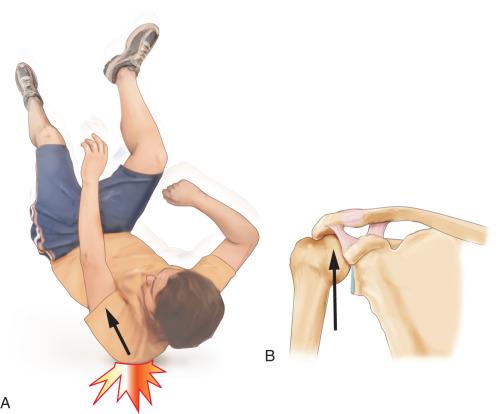
The complete AC joint examination must include inspection, palpation, range of motion (ROM), strength, sensation, and stabilization assessments of both shoulders, after which special tests specific to the AC joint can be performed. An examination for neural, vascular, or additional injuries of the adjoining joints should always be completed. The clinician should be aware of and test for any appropriate cervical spine and/or glenohumeral joint pathologic conditions that, if present, may confuse the clinical picture. Similarly, other disease processes including gout, pseudogout, and chondromatosis should be considered and ruled out.
The initial physical examination of the patient with a suspected AC joint injury should include observation of the patient either standing or sitting so that the weight of the arm pulling downward stresses the AC joint making any deformity (superior prominence of the distal clavicle) more apparent. When examining a patient for suspected AC joint injuries, the clinician must be sure to examine the entire clavicle and AC joints because of the possibility of biclavicular dislocations.
After inspection, the clinician should attempt to isolate the location of the patient's pain via direct palpation. Traumatic pathology of the AC joint is identified by pain, swelling, and point tenderness at the AC joint. In AC joint injuries, the patient most often reports pain originating from the anterosuperior aspect of the shoulder. However, isolating the structure responsible for anterosuperior shoulder pain can be a diagnostic challenge because of the innervation of the AC joint and the superior aspect of the glenohumeral joint. The lateral pectoral nerve provides innervation to the anterior aspect of the AC joint and surrounding structures of the shoulder, whereas the suprascapular nerve provides innervation to the posterior aspect of the AC joint and other posterior structures of the shoulder. Gerber and colleagues evaluated patterns of pain and found that irritation to the AC joint produced pain over the AC joint, in the anterolateral neck, and in the region of the anterolateral deltoid. Irritation of the subacromial space produced pain in the region of the lateral acromion and lateral deltoid muscle but did not produce pain in the neck or the trapezius region. If a patient has more pain than expected for a simple AC joint injury, a coracoid fracture or a type IV injury with displacement of the clavicle through the trapezial fascia should be suspected.
In type III injuries, both the AC and CC ligaments are torn, with no significant disruption of the deltoid or trapezial fascia. The upper extremity is held in an adducted position with the acromion and upper extremity displaced inferior to the horizontal plane of the lateral clavicle. Severe pain persists with motions even 1 to 3 weeks after injury. Patients should be evaluated 3 to 6 weeks after injury to allow for a thorough examination, which is typically not possible in the acute phase due to significant pain. Therefore the patient should be referred to a physiotherapist to improve ROM and re-establish scapular kinematics after initial examination.
Several physical examination techniques are available to help identify and isolate AC joint disease. Diagnostic tests specific to the AC joint: cross-arm adduction test, active compression test, AC resisted extension test, the Paxino test, and the Hawkins-Kennedy sign. Previous studies have reported sensitivities of 77% for the cross-body abduction test, 72% for the AC resistance test, and 41% for the active compression test, respectively; however, the combination of all 3 tests has a reported high specificity of 95%. Of note, several of the AC-specific tests are more specific for AC arthrosis and distal clavicle osteolysis as opposed to unstable AC joint disease. In some cases, the injection of a local anesthetic agent into the AC joint may relieve the pain implicating AC joint etiology. The examination should be performed before and after injection to determine whether changes in symptoms occurred. Likewise, physical examination can help differentiate the different types of AC joint injuries ( Table 56.2 ). For example, type III injuries can often be distinguished from type V injuries by having the patient shrug both shoulders. Type III injuries are reducible with a shoulder shrug because the integrity of the deltotrapezial fascia has not been compromised.
| Type | AC Ligament Injury | CC Ligament Injury | Deltotrapezial Fascia | Clinical Findings | Radiographic Findings |
|---|---|---|---|---|---|
| I | Intact | Intact | Intact | AC tenderness | Normal |
| II | Ruptured | Intact | Intact | Pain with motion; the clavicle is unstable in the horizontal plane | The lateral end of the clavicle is slightly elevated; stress views show <100% separation |
| IIIA, stable | Ruptured | Ruptured | Mild injury | Clavicle is unstable in both the horizontal and vertical planes and acromion is depressed relative to the clavicle; much improved functionally and with pain after 3–6 weeks nonop management | Radiographs and are abnormal—100% separation; less overriding of clavicle on acromion the IIIB injuries |
| IIIB, unstable | Ruptured | Ruptured | Mild injury | Continued abnormal scapular movement, pain, weakness, and poor ROM after 3–6 weeks nonop treatment | Cross body stress adduction x-ray showing overriding clavicle on acromion |
| IV | Ruptured | Ruptured | Injured as the clavicle is posteriorly displaced | Possible skin tenting and posterior fullness | The clavicle is displaced posteriorly on the axillary view |
| V | Ruptured | Ruptured | Injured and stripped off the clavicle | A more severe type III injury, shoulder with severe droop; if a shoulder shrug does not reduce it, then it is a type V injury | A 100%–300% increase in the clavicle to acromion distance |
| VI | Ruptured | Ruptured | Possible injury | Rare inferior dislocation of the distal clavicle; accompanied by other severe injuries; transient paresthesias | The clavicle is lodged behind the intact conjoined tendon |
Cross-arm adduction test: This test is performed with the arm elevated to 90 degrees and then adducted across the chest with the elbow bent at approximately 90 degrees. The described motion causes compression across the AC joint, leading to pain. Of note, this motion can also produce pain in the posterior aspect of the shoulder that is associated with a tight posterior capsule or at the lateral aspect of the shoulder, which can be associated with rotator cuff pathology ( Fig. 56.7A ).
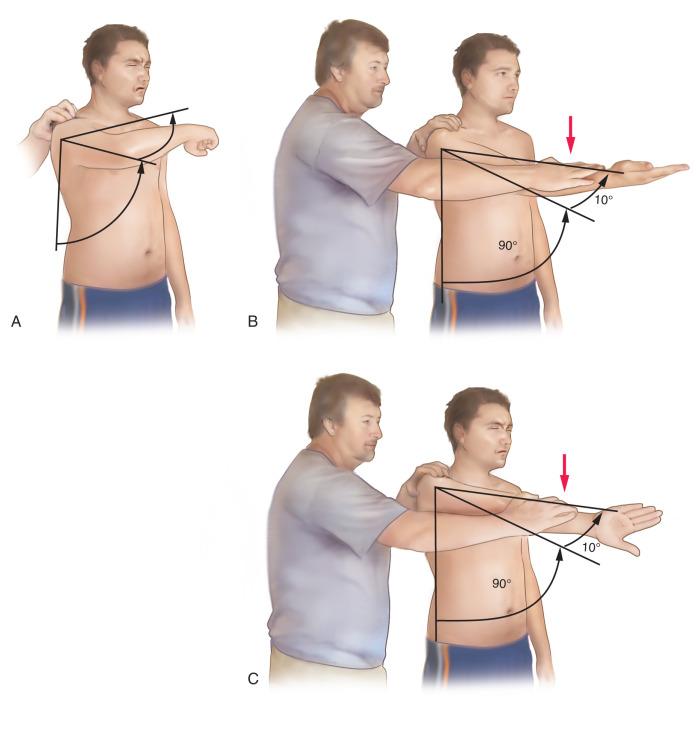
Active compression test (O ' Brien test): This test is performed with the arm elevated to 90 degrees and adducted to 10 to 15 degrees with the elbow in extension, followed by maximal pronation of the forearm with obligate internal rotation of the arm as the examiner applies a downward force resisted by the patient. The described positioning of the shoulder causes the greater tuberosity of the humerus to elevate the depressed acromion with the addition of applied resistance resulting in the “lock and load” of the AC joint. Symptoms referred to the top of the shoulder and confirmed by examiner palpation of the AC joint indicate damage to this structure, whereas symptoms referred to the anterior glenohumeral joint suggest labral or biceps disease. Therefore this test can be useful in differentiating AC joint disease from intra-articular disease (see Fig. 56.7B and C ) .
AC resisted extension test: This test is performed with the arm flexed to 90 degrees and the elbow bent to 90 degrees. The patient is asked to extend the arm against resistance, and the test is positive if pain is reproduced around the AC joint.
Paxino test: To perform this test, the examiner places thumb pressure at the posterior AC joint to cause reproducible pain.
Hawkins-Kennedy sign: This test was originally described regarding the diagnosis of impingement syndrome by causing pain with forced passive internal rotation behind the back and forced adduction with internal rotation. Because impingement syndrome can lead to involvement of the AC joint, the maneuver has been shown to reproduce AC joint-related pain.
Injury to the AC joint not only affects glenohumeral function but also may have a negative effect on scapulothoracic function and scapulohumeral dynamics. The clavicle is the anterior strut supporting the scapula, and proper function of the AC and CC ligaments contributes significantly to the physiologic motion of the scapula. AC joint instability may position the scapula in a protracted and internally rotated position. Prior studies have reported that scapular dyskinesis may lead to deficits in motion as well as glenohumeral and lateral shoulder pain. Clinical evaluation of the scapula can determine the presence or absence of alterations in scapular position or motion, collectively called “scapular dyskinesis,” and can help guide effective treatment for associated functional deficits. A reliable examination can be performed within 10 days after acute injury, when the immediate symptoms have subsided. The clinician should position themselves behind the patient and examine both scapulae to assess resting scapular with both the patient's arms held at their side. It is important to assess for asymmetry of the medial scapular border as prominence indicates excessive scapular internal rotation and/or anterior tilt, which can result in functional deficits in rotator cuff strength and arm motion in flexion and abduction secondary to scapular dyskinesis. This medial scapular border prominence can result when the scapular strut is compromised either from isolated injury to the AC ligaments (type II) or injury to both AC and CC ligaments (type III and higher). Therefore any AC joint separation that results in scapular dyskinesis will potentially create physiologic and biomechanical deficits affecting maximal shoulder function. Patients who demonstrate these problems on physical exam should be considered for repair or reconstruction of both the AC and CC ligaments.
Overall, the clinical diagnosis of AC joint disease after a traumatic event can be determined via a triad of (1) point tenderness to palpation at the AC joint, (2) pain at the AC joint with cross-arm adduction, and (3) relief of symptoms by injection of a local anesthetic agent. Meanwhile, diagnosis of AC joint pathology resulting from nontraumatic or chronic overuse can often be accomplished via the cross-arm adduction test, the active compression test, and the AC resisted extension test. Chronopoulos et al. reported that the AC resisted extension test combined with the cross-arm adduction test had the greatest sensitivity, whereas the active compression test had the greatest specificity and the highest overall accuracy for diagnosis of these injuries.
A complete, standard shoulder radiographic series should be obtained in the setting of an AC joint injury, particularly in high degrees of AC joint dislocation, as associated injuries of the glenohumeral joint are reportedly common. Varying configurations of the AC joint as well as vertical CC translation can be delineated on a standard AP radiograph; however, this shoulder view is not specific to the AC joint. Therefore the radiographic workup AC joint disease should include a bilateral Zanca view, which visualizes the ipsilateral and contralateral AC joints on a single x-ray cassette while maintaining the same orientation of the x-ray beam. The view is obtained by tilting the x-ray beam 10 to 15 degrees cephalad and using only 50% of the standard shoulder AP penetration strength. By visualizing both AC joints on the same cassette, the CC distance can be compared from side to side, also allowing for future comparison of preoperative and postoperative examination findings. The reduced radiographic penetration from that which is standard for the denser glenohumeral joint on an AP shoulder radiograph prevents overpenetration of the AC joint (too dark), which can result in the misinterpretation of subtle pathology. As determined by Zanca, the normal AC joint width is between 1 and 3 mm, although this width diminishes with age ( Fig. 56.8 ). Likewise, the normal anatomic CC interspace is approximately 1.1 to 1.3 cm, although this interval does exhibit variability, as demonstrated by Bosworth. Bearden et al. reported a 25% to 50% increase of the CC interval compared with the contralateral shoulder as indicative of complete CC disruption.
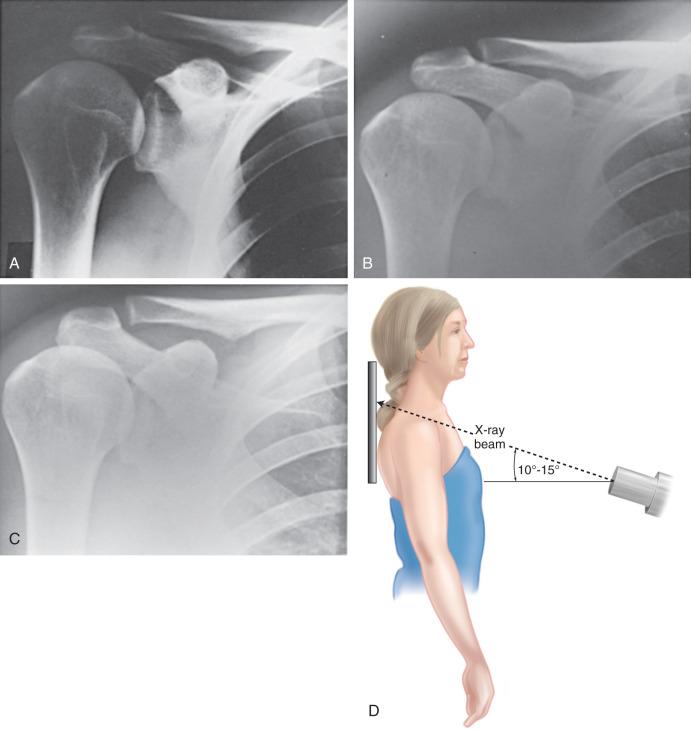
An axillary view is useful in visualizing posteriorly displacement of the distal clavicle in relation to the acromion, which occurs in type IV AC joint injury where the scapula displaces anteromedially. However, caution must be taken when diagnosing posterior translation of the distal clavicle based on this view because recent studies have reported difficulties in identifying a posteriorly translated clavicle on an axillary radiograph.
The cross-body adduction radiograph (so-called Basamania view) is reported to differentiate between a stable and unstable AC joint. If the clavicle overrides the acromion on the cross-body adduction view, it indicates instability of the CC ligaments in addition to the AC joint disruption. In this imaging technique, a crossbody adduction AP view of the AC joint with the arm elevated to 90 degrees is used to assess clavicle overlap of the acromion secondary to anteromedial translation of the scapula. In 1949, Alexander described a similar radiographic imaging technique for AC joint instability.
The stress view of the AC joint is obtained by placing 5 lb on each wrist and essentially taking an AP view of both shoulders and is mainly used to differentiate between type II and III dislocations. However, the difference in type II and III injuries is rarely significant, and the classical stress views with distal traction are not typically necessary for diagnosis. Patients who present with a clinically obvious AC injury and deformity suggestive of complete dislocation (types III, IV, V, and VI) often demonstrate maximal CC interspace widening on routine AP view and thus do not require stress views ( Fig. 56.9 ).
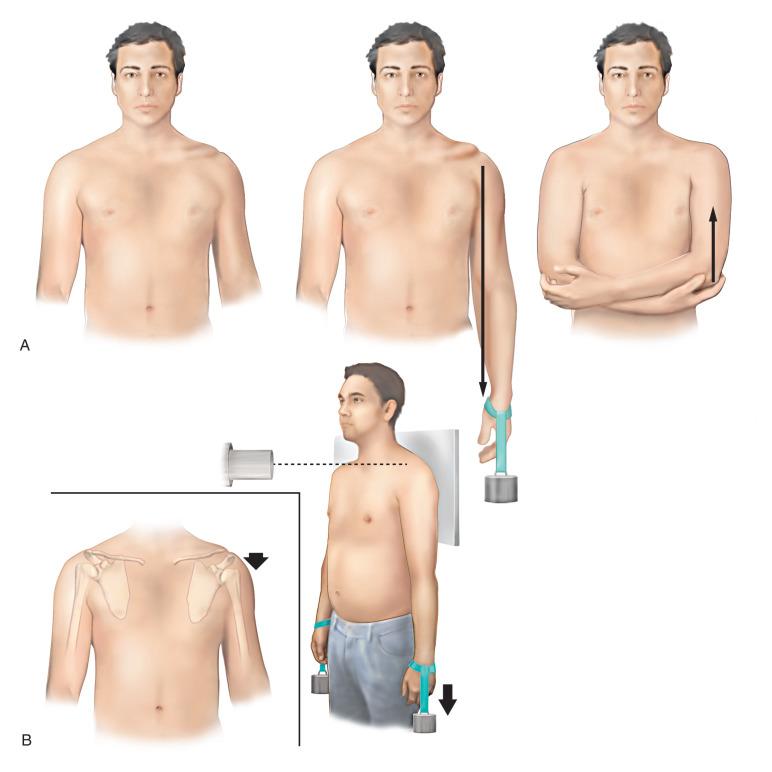
The Stryker notch view is useful for determining a coracoid fracture when clinical suspicion is high for AC joint dislocation despite a normal CC interval on the standard AP view of the shoulder ( Fig. 56.10 ). Coracoid process fracture should be suspected when radiographs show AC dislocations with a normal CC distance. This view is taken with the patient supine and his or her palm (affected side) placed on their head while the x-ray beam is tilted 10 degrees cephalad.
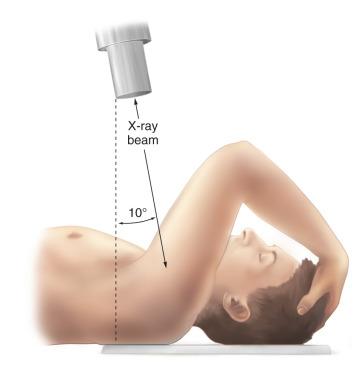
Treatment options for AC joint injuries continue to evolve ( Table 56.3 ). The overall goal, regardless of injury severity or treatment, is to regain full, stable, and pain-free ROM normal strength, and no limitations in activities. The demands on the shoulder will differ among patients, and these demands should be considered during the initial evaluation, as well as ascertaining patient expectations. Initially nonoperative treatment (i.e., use of a sling, ice, analgesics, and immobilization) should be attempted for all patients with incomplete (types I and II) AC joint injuries. Although no current evidence supports the recommendation of surgical intervention for type I or II injuries, some studies have demonstrated persistent symptoms years after nonoperative treatment.
| Treatment Classification | Essentials of Repair | Clinical and Operative Considerations | Level of Evidence |
|---|---|---|---|
| AC ligament repair | The AC ligament is repaired with reinforcing pin(s), screw, or plate | The implant is usually removed | IV |
| Dynamic muscle transfer | Transfer of the short head of the biceps with or without coracobrachialis | Partial transfer of structures—may alter shoulder mechanics | IV |
| CA ligament transfer | Transfer of CA ligament alone or in concert with other procedures | Preserve the length of the CA ligament | IV |
| CC ligament repair | Traditionally the Bosworth screw technique—wires, suture loops, and grafts have been described | Usually requires a second procedure for hardware removal | IV |
| Distal clavicle resection with CC reconstruction | Classically, the distal clavicle is excised and the CC is reconstructed using CA ligament | Can also be a salvage procedure for persistent pain after an AC dislocation (especially for type I and II injuries) | IV |
| Distal clavicle resection without CC reconstruction | IV | ||
| Arthroscopic repair and reconstruction | Repair or reconstruction arthroscopically viewed from the subacromial space of CC ligaments | Technical reports have described the efficacy of the procedure | VI |
| Anatomic reconstruction of the CC ligaments | Reconstruction of CC ligaments using soft tissue grafts to reapproximate the conoid and trapezoid ligaments | Potential advantages of improved horizontal plane stability | IV |
For patients with complete AC joint injuries (i.e., types IV, V, and VI), treatment is typically operative because of the significant morbidity associated with persistently dislocated joints and severe soft tissue disruption. In the randomized controlled trial of 12 patients with type V AC joint dislocations, Bannister and colleagues demonstrated superior results with operative treatment with CC screw and AC joint fixation compared with nonoperative treatment.
Treatment of type III injuries remains controversial, with a trend toward initial nonoperative treatment in most cases. Factors involved in the decision-making process include activity level, type of sport/work, timing of injury within the athletic season, and throwing demands on both the injured and the contralateral shoulders. The ISAKOS Terminology Project suggested a revision to the Rockwood classification by further subdividing the type III AC joint injuries into type IIIA (stable) and type IIIB (unstable). This subclassification is primarily based upon functional rather than anatomic criteria. Type IIIA injuries are defined as those without overriding of the clavicle on the cross-body abduction radiograph and without significant scapular dysfunction, while unstable type III injuries demonstrate therapy-resistant scapular dysfunction after 3 to 6 weeks of conservative management and overriding of the clavicle on the cross-body abduction radiograph. Unstable type III lesions (type IIIB) will continue to cause pain (usually on the anterior acromion, rotator cuff, and medial scapular area), weakness during rotator cuff testing, decreased flexion and abduction ROM, and demonstrable scapular dyskinesis. A basic algorithm has been proposed regarding high-level athletes with type III injuries. If the athlete is currently within his or her playing season, then consideration of an intra-articular injection of lidocaine and return to sport may be considered. If the athlete is not in the midst of his or her playing season, then he or she should undergo functional rehabilitation for up to 3 months followed by either return to full activity (if asymptomatic) or consideration of surgery (if symptomatic). Evidence supporting nonoperative treatment of type III AC dislocations has been reported in a meta-analysis performed by Phillips and colleagues, in which 88% of operatively treated patients and 87% of nonoperatively treated patients (a total of 1172 patients) had satisfactory outcomes. Complications included the need for further surgery (59% operative vs. 6% nonoperative), infection (6% vs. 1%), and deformity (3% vs. 37%). Pain and ROM were not significantly affected regardless of the treatment choice. Overall, based on the available evidence, the authors did not recommend surgery for type III AC joint injuries in young patients. Likewise, a more recent article reported that more than 70% of patients successfully completed nonoperative treatment for type III AC joint injury at a mean follow-up of 3.5 years with excellent outcome scores. Moreover, Petri et al. also reported that patients who failed nonoperative treatment and subsequently underwent AC joint reconstruction had similar outcome scores compared with those who successfully completed nonoperative treatment after a mean follow-up of 3.3 years. These results indicate that a trial of nonoperative treatment is warranted because successful outcomes can be expected even in patients who eventually opt for surgery. However, it should be noted that patients who did not proceed to AC joint reconstruction were less likely to return to their preinjury level of sports participation, suggesting that some amount of shoulder dysfunction may be present despite promising outcome scores.
McFarland and associates published the results of a survey of Major League Baseball team physicians evaluating treatment modalities for a type III injury in pitchers. Of the respondents, 69% reported that they would opt for nonoperative treatment. Of the 32 patients with type III injuries, 20 were treated nonoperatively and 12 were treated operatively. Complete pain relief and normal function was achieved in 80% of the patients treated nonoperatively and in 91% of the patients treated operatively. A recent survey of American Orthopaedic Society for Sports Medicine members indicated that 86% of respondents preferred nonoperative treatment for their patients with type III injuries. In a recent consensus statement published by the International Society of Arthroscopy, Knee Surgery and Orthopaedic Sports Medicine (ISAKOS), a trial of nonoperative treatment was recommended for 3 to 6 weeks in all patients with grade III AC joint injuries. They suggested operative management if, after this period, there was persistent pain and abnormal scapular motion. The decision to pursue operative management should be weighed against the high reported rate of complications (as high as 80%) with current techniques, including coracoid and clavicle fractures, hardware failure, loss of reduction, graft ruptures, and adhesive capsulitis.
The main goals of treatment, whether surgical or nonsurgical, are to achieve a pain-free shoulder with full ROM, strength, and no limitations in activities. The demands on the shoulder will differ from patient to patient, and these demands should be considered during the initial evaluation. As already discussed, type I and type II AC joint separations are typically treated nonoperatively, and there is merit for nonoperative management of type III injuries with the decision for surgery after an initial 3 to 6 weeks of conservative management. Patients should be evaluated as early as possible by a physiotherapist to regain as much movement and scapular control as possible, which is especially important for those presenting with type III injury. A second evaluation for type III lesions should be performed 3 to 6 weeks after injury and always completed within 3 months. The decision for surgery should be made on a case-by-case basis, considering heavy labor occupation, position/sport requirements (e.g., quarterbacks and pitchers), therapy-resistant scapulothoracic dysfunction, capacity to cooperate with postoperative protocols and risk for reinjury. The new classification of type IIIA and type IIIB lesions helps to differentiate and better identify patients who would benefit from surgical intervention. Some patients will have persistent pain and an inability to return to their sport or job after 3 to 6 weeks of conservative management. Nevertheless, subsequent surgical stabilization will still allow eventual return to sport or work in such cases with reported equivalent outcome scores to those undergoing acute surgical management of type III injuries.
Patients with types IV, V, and VI injuries are generally treated operatively. Some literature supports reduction of the clavicle in type IV, V, and VI injuries, turning them into a type III injury and then treating them conservatively. Numerous surgical procedures for the treatment of injuries greater than type IV exist; however, none has proved to be the gold standard. Likewise, higher level studies are needed before a gold standard treatment algorithm for type III injuries can be provided. Nevertheless, specific criteria should be used when treating AC joint dislocations surgically: (1) Biologic augmentation, namely tendon graft, should be used in the chronic situation (>3 weeks after injury), and (2) anatomic techniques for surgical reconstruction should be favored.
General nonoperative treatment involves the use of a sling with ice and anti-inflammatory agents, as well as a brief period of immobilization typically lasting 3 to 7 days. The use of the sling is recommended until the pain has subsided, which typically takes 1 to 2 weeks for type I injuries and upward of 3 weeks for type II injuries. The patient is encouraged to initiate range-of-motion activities within the first week after injury to attempt reduction of pain and inflammation, and thus decrease associated morbidity. Prior to return to athletic activity, a four-phase rehabilitation protocol has been described by Gladstone and colleagues. Phase 1 includes pain control, sling use, immediate protective ROM, and isometric exercises. We also incorporate closed chain scapular exercises. Phase 2 involves ROM exercises to restore full mobility and a gradual progression of strengthening with the addition of isotonic exercise. Phase 3 involves unrestricted functional participation with the goal of increasing strength, power, endurance, and neuromuscular control. Finally, Phase 4 involves return to activity with sports-specific functional drills ( Figs. 56.11–56.14 ). Full rehabilitation should be achieved within 6 to 12 weeks.
Phase 1: The first phase of nonoperative treatment (see Fig. 56.11 ) is to decrease pain, thus allowing early ROM to nourish the cartilage and maintain maximal soft tissue function. Ice and some short-term immobilization can be used in this phase to decrease pain and reduce inflammation. Active-assisted ROM is begun as early as possible for shoulder internal–external rotation and elevation–depression of the arm in the plane of the scapula (30 to 45 degrees of abduction and 30 to 40 degrees of forward flexion). It is important for the patient to reach the ROM where pain begins but not go beyond this point. Arm elevation in abduction allows the clavicle to rotate upward, which stresses the AC ligament and can further increase pain and inflammation, and thus the athlete is instructed not to perform this motion. Isometric motions to decrease the atrophy of the surrounding muscular groups in the shoulder are shoulder flexion and internal and external rotation, which do not cause the clavicle to rotate. We prefer to start with closed-chain scapular activities that are easily tolerated early in the postinjury period, allowing the patient to work on scapular strength and motion without provoking undesirable increases in symptoms. The patient or athlete is transitioned to the second phase when the ROM and forward elevation are relatively pain free or with minimal pain up to 140 degrees of flexion and maximal external rotation compared with the contralateral arm. The criteria to advance to phase 2 are (1) 75% of full ROM, (2) minimal pain and tenderness on palpation of the AC joint, and (3) a manual muscle test grade of 4 out of 5 for the anterior deltoid, middle deltoid, and upper trapezius.
Phase 2: The main goal of phase 2 (see Fig. 56.12 ) is to help a patient advance to full painless ROM and increase strength in an isotonic arc. Active-assisted motion exercises, allowing up to full forward flexion and internal and external rotation, are performed with 90 degrees of shoulder abduction, as well as with the arm at the patient's side. Strengthening exercises are directed toward the deltoid, trapezius, and rotator cuff. Press maneuvers, such as the bench press or the military shoulder press, are limited because they increase the stress in the AC joint. The criteria for advancing from phase 2 to phase 3 are pain-free ROM, no pain or tenderness on palpation, and strength that is 75% that of the contralateral side.
Phase 3: The main goal of phase 3 (see Fig. 56.13 ) is to increase the strength of the entire shoulder complex musculature. Specific exercises emphasized during this phase are isotonic dumbbell shoulder flexion, abduction, shrugs, and bench press (see Fig. 56.14 ).
Phase 4: Transition to phase 4, which involves sport-specific exercises, is allowed once the patient achieves (1) full range of the motion, (2) no pain or tenderness, (3) satisfactory clinical examination, and (4) isokinetic strength approaching 100% and restored ROM compared with the contralateral uninjured side (if available). These isokinetic tests are performed at 180 degrees per second and 300 degrees per second (see Fig. 56.14 ).
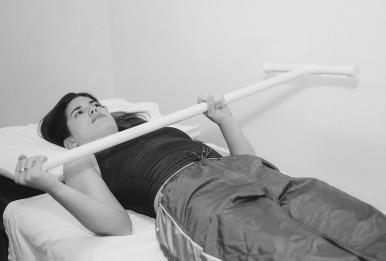
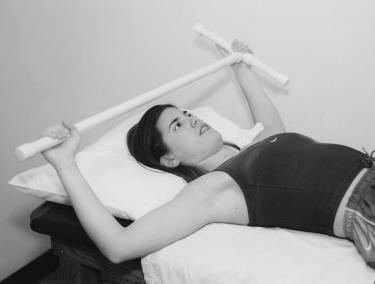
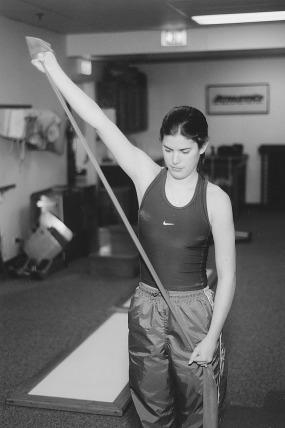
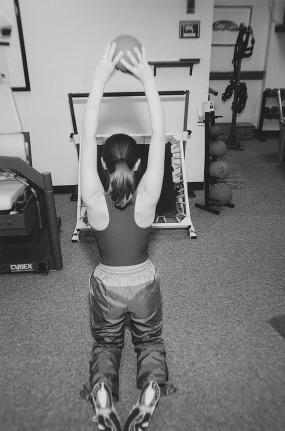
Despite the prevalence and success of nonoperative management of AC joint injuries, much of the literature has focused on surgical treatment. Operative treatment of types IV, V, and VI is generally recommended because of morbidity associated with persistent marked displacement of the distal clavicle, although good results with conservative management have been reported. A closed reduction maneuver should be attempted because these types of dislocations can sometimes be reduced into a position that mimics a type III injury, then treated nonoperatively.
The literature is replete with surgical techniques to address complete AC dislocations, with more than 75 different techniques described in various reports. Most techniques are based on several basic types of procedures, including (1) primary AC joint fixation with pins, screws, or rods; (2) coracoacromial ligament transfer (Weaver-Dunn) ± distal clavicle excision; (3) anatomic CC reconstruction; and (4) arthroscopic suture fixation. Nearly all the recently reported “novel” techniques involve combinations of the basic techniques, modifications of these techniques, and/or modifications of the modifications.
In addition to primary repair, these procedures can include reconstruction augmentation with autogenous tissue (coracoacromial ligament), augmentation with absorbable and nonabsorbable suture and prosthetic material, and CC stabilization with metallic screws. The Weaver–Dunn technique using transfer of the coracoacromial ligament has been the most popular procedure in acute and chronic injuries. Several more recent reports have described good results with modifications of this technique. However, compromised results have been observed in patients after Weaver-Dunn-based procedures with residual subluxation or dislocation after surgery. Ammon and associates performed a biomechanical study comparing the Bosworth screw with a poly-L-lactic acid bioabsorbable screw and found that the Bosworth screw provided superior strength (native ligament, 340 N; poly-L-lactic acid screw, 272 N; and Bosworth screw, 367 N).
From a biomechanical perspective, the importance of the CC ligaments and AC ligaments in controlling superior and horizontal translations has been elucidated. In fact, failure to surgically reproduce the conoid, trapezoid, and AC ligament function with current techniques may explain the observed incidence of recurrent instability and pain. Several authors have advocated using a separate and potentially more robust graft source to improve surgical results. The use of a free autogenous or allograft tendon has been further supported biomechanically. Other reconstruction grafts, such as the lateral half of the conjoined tendon, have also been described. Anatomic reconstruction of the CC ligaments has been shown to be biomechanically superior when compared with previous surgical constructs. Other types of fixation have been biomechanically evaluated, including interference screw fixation, suture cerclage, and suture anchors. Although none of these techniques fully restored native AC joint stability, they were all found to be superior to the Weaver-Dunn procedure. Thus given the biomechanical limitations of CA ligament transfer, newer techniques involve augmentation with CC ligament reconstruction using tendon grafts, suture anchors, screws, or suture loops.
The major surgical options for AC joint reconstruction are included in the following summary:
Primary AC joint repair involves primary repair of the AC ligament with reinforcement of the superior AC ligament with joint meniscus. The repair is typically augmented with smooth or threaded pins, screws, suture wires, or plates (e.g., an AC joint plate or hook plate). This technique features limited surgical dissection; however, it places the patient at risk for pin migration ( Fig. 56.15 ) .
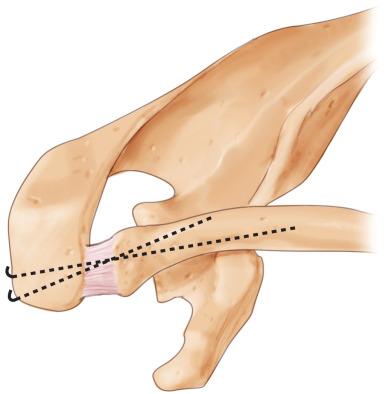
Coracoacromial ligament transfer (Weaver-Dunn) with or without distal clavicle excision involves transfer of the coracoacromial ligament from the acromion to the clavicle as a substitute for the ruptured CC ligament with or without distal clavicle excision ( Fig. 56.16 ) .
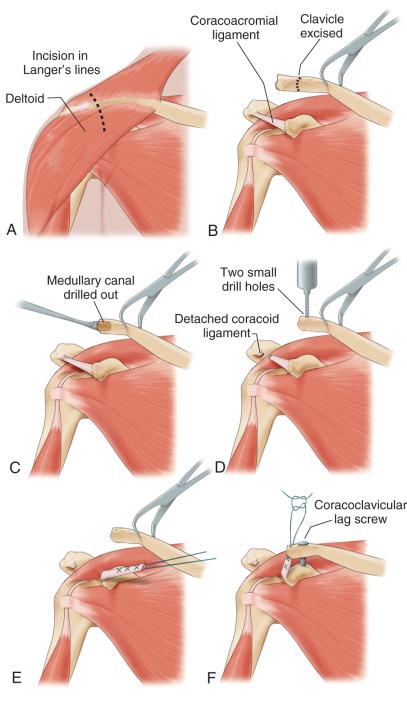
Debate exists regarding distal clavicle excision:
If the patient's condition is very acute, if AC joint arthrosis is minimal, and/or if stability is of paramount concern, one may consider keeping the distal clavicle, especially because recent biomechanic evidence has suggested increases in horizontal translation with sequential resection.
If the patient has a chronic injury or preexisting AC joint arthrosis, consideration of excision can be made.
Modification to the Weaver-Dunn procedure includes transfer of the conjoined tendon to the distal clavicle, augmentation with a suture loop, and augmentation with a semitendinosus autograft or anterior tibialis allograft via a bone tunnel and interference screw fixation.
Anatomic CC reconstruction involves arthroscopy, distal clavicle excision, and reconstruction with an autograft or allograft. Biomechanically, this technique has been shown to better reapproximate the stiffness of the native CC ligament complex and improve anterior and posterior translation restriction compared with the Weaver-Dunn procedure, and is described in detail in the Authors’ Preferred Technique section.
Arthroscopic suture fixation involves restoration of the CC ligaments arthroscopically using two suture anchors through four drill holes in the clavicle with an associated CC ligament transfer. The suture anchors are thus fixed to the coracoid as the suture is tied over a bone bridge to the clavicle. Similarly, tightrope devices have been used as well, and this technique is also arthroscopic, involving two single tunnels through the clavicle and coracoid through which to feed the tightrope device.
A curvilinear center incision is placed approximately 3.5 cm from the distal clavicle or AC joint, along Langer's lines toward the coracoid process ( Figs. 56.17 and 56.18 ).
Control of superficial skin bleeders down to the fascia of the deltoid is accomplished with a needle-tip bovie.
Once the entire clavicle is palpated, full-thickness flaps are made. Care must be taken to avoid button-holes when creating skin flaps due to poor wound healing potential.
Care is then taken to remove the deltoid off the clavicle both anteroinferiorly and posterosuperiorly
Soft-tissue attachments along the medial coracoid are carefully released to allow for later graft passage.
We do not perform a distal clavicle resection to prevent destabilization of the AC joint.
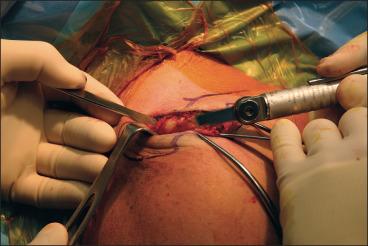
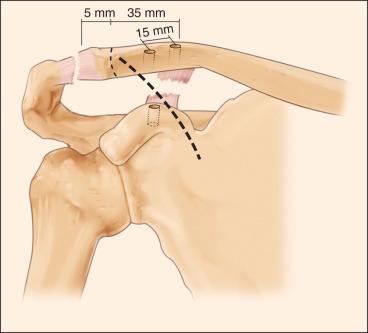
Selection depends on the surgeon's preference. We prefer peroneus longus allograft fresh-frozen tendon (5 mm) or semitendinosus autograft whip-stitched with no. 2 FiberWire sutures (Arthrex Inc.) in a baseball-type fashion at both distal tails of the graft (2 to 2.5 cm). An ideal graft models a bullet, where the distal diameter is narrower than the than the proximal diameter. This is accomplished by adding additional stitches to the distal tip of the graft to tabularize ( Fig. 56.19 ).
The diameter of the graft is measured with a standard tendon-measuring device or using the handle of a repair system (Biotenodesis System, Arthrex Inc.) to determine the graft size (see Fig. 56.19 ).
The graft is placed on the table in a moist sponge until the bone tunnels are prepared.
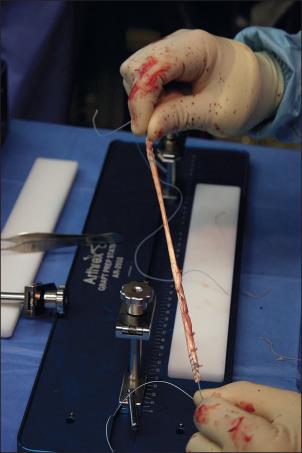
The coracoid is carefully dissected making sure to release all soft-tissue attachments laterally and medially all the way to the base.
The AC joint is anatomically repositioned, and bone tunnels are created in the clavicle. It is critical that the bone tunnels are placed anatomically to recreate the CC ligament ( Fig. 56.20 ); these tunnels should be separated by a minimum of 20 mm.

The first tunnel for the conoid ligament (medial limb). Measuring approximately 45 mm medial from the lateral edge of the distal clavicle and localized to the posterior half of the clavicle, the conoid tunnel is made in a superior-to-inferior direction. The footprint of the conoid ligament is extremely posterior, along the posterior edge of the clavicle, which is why making this bone tunnel as posterior as possible (i.e., in the posterior half of the clavicle) is extremely important.
The second tunnel is for the trapezoid ligament. This is placed centrally within the clavicle approximately 25 mm from its lateral edge due to the better bone mineral density within the anatomic insertion area of the CC ligaments (between 20 and 50 mm from the lateral end of the clavicle). Low bone mineral density has been shown to correlate with decreased load to failure, so care must be taken not to drill a tunnel too lateral in the clavicle.
A cannulated reamer guide pin is used for placement of the tunnels. Two guide pins are used before reaming to confirm accurate placement of the tunnels.
For the conoid ligament tunnel, the guide pin is angled about 45 degrees from the direct perpendicular of the clavicle to re-create the oblique nature of the ligament.
For the trapezoid ligament tunnel, which is a more anterior and lateral structure than the conoid, the guide pin is drilled in the center point of the clavicle, about 25 mm medial to the AC joint.
A 5-mm reamer is used to create each tunnel with careful attention to confirm that the conoid tunnel is as posterior as possible in the clavicle without “blowing out” the posterior cortical rim ( Fig. 56.21 ). A 5.5-mm tap is then used.
After tunnel reaming, copious irrigation follows to remove any bone fragments.

The tendon graft is looped around the base of the coracoid process, which can be facilitated with the use of a curved aortic cross-clamp (Satinsky clamp) and a suture-passing device. While the graft is passed, a no. 2 FiberWire or FiberTape (Arthrex Inc.) is also passed around the base of the coracoid, which will serve as a nonbiologic fixation reinforcement and help reduce the clavicle to the scapula ( Fig. 56.22 ).

The tendon graft limb exiting the conoid tunnel is first fixed using a bioabsorbable or inert (polyetheretherketone [PEEK]) interference screw. We use 5.5 mm diameter screws of 3 different lengths depending on clavicle thickness (5.5 × 8 mm, 5.5 × 10 mm, 5.5 × 12 mm).
The opposite graft limb exiting the trapezoid tunnel is cyclically tensioned to remove all slack from the system, and a similarly sized screw is subsequently placed into the trapezoid ligament tunnel to fix this end of the graft.
One limb of the biologic graft is taken and placed through the posterior bone tunnel, recreating the conoid ligament ( Fig. 56.23 ). The other limb is passed through the anterior bone tunnel, recreating the trapezoid ligament.
While the graft is brought through the tunnel ( Fig. 56.24 ), a no. 2 high-strength suture is also brought through the respective bone tunnels ( Fig. 56.25 ).
For reduction purposes, superiorly directed displacement of the scapulohumeral complex by the assistant reduces the AC joint. Likewise, large point-of-reduction forceps placed on the coracoid process and the clavicle can further help with reduction while securing the tendon grafts.
With the AC joint anatomically reduced and with the tendon graft sufficiently taut, a 5.5 mm PEEK interference screw is placed in either the posterior or the midline bone tunnel.
A no. 2 high-strength suture or FiberTape (Arthrex Inc.) is brought up through this cannulated screw hole, and the second PEEK interference screw is placed in the remaining bone tunnel.
With both grafts secured using interference screw fixation, the no. 2 suture or FiberTape (Arthrex Inc.) is tied over the top of the clavicle, becoming a nonbiologic fixation for the overreduced AC joint ( Figs. 56.26 and 56.27 ).
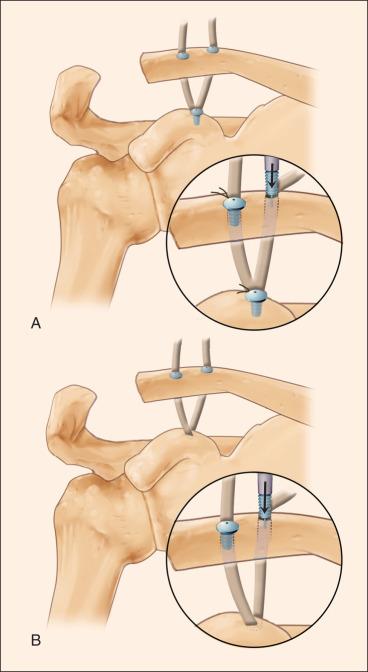
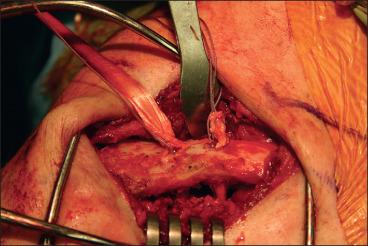
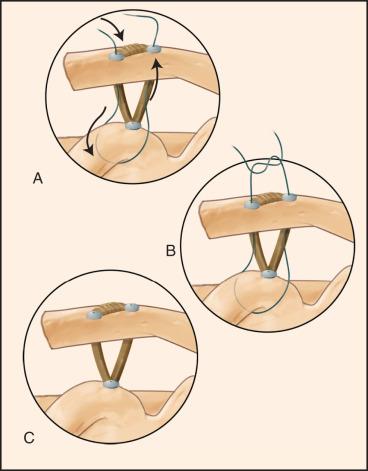
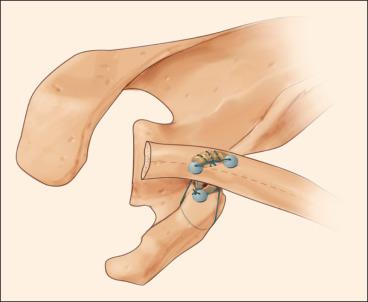
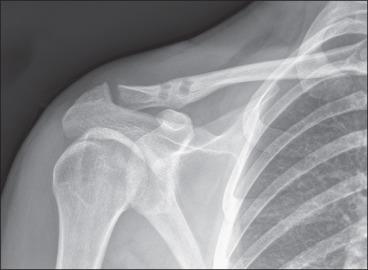
The remaining lateral trapezoid graft limb is looped over the top of the AC joint to reinforce the repair and reconstruct the AC joint capsule.
High-strength nonabsorbable sutures are used to suture the graft limb into the most posterior tissue on the acromial side of the joint.
The remaining graft is shuttled underneath the AC joint from posterior to anterior and again sutured to the acromial side of the joint and itself.
Finally, the superior AC capsule is sutured.
This technique, which involves direct wrapping and suturing of the remaining graft around the AC joint, has been demonstrated to be biomechanically superior to other methods of AC ligament reconstruction and most closely restore native joint biomechanics.
Alternatively, the remaining graft limbs may be incorporated into the soft-tissue deltoid and trapezial repair to the clavicle.
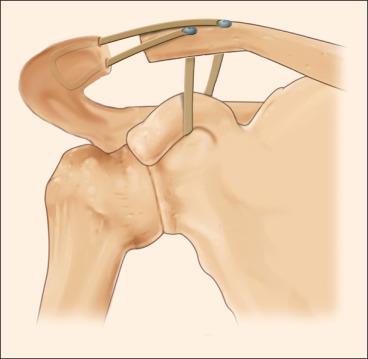
One of the most important concepts with AC or CC joint reconstruction is closure of the deltotrapezial fascial flaps from the dissection.
A nonabsorbable suture, in a modified Mason-Allen-type fashion, is placed through the deltoid fascia. Six or seven sutures are used, and the knots are tied on the posterior aspect of the trapezius.
This closure of the deltotrapezial fascia should completely obscure the grafts, as well as the clavicle.
If any concern exists regarding the fascial repair, the deltoid can be repaired through small drill holes in the anterior cortex of the clavicle.
The subdermal skin is closed with 2-0 or 3-0 absorbable sutures, and the skin itself is closed with either a 2-0 running or interrupted nylon suture, everting the skin edges.
A compression dressing is applied, and the patient is placed in a supportive sling with external rotation to 0 degrees and an upward force on the arm.
Postoperative management after AC joint stabilization depends on the procedure performed. If the procedure includes only a distal clavicle resection, then a short (1- to 3-day) period of immobilization is followed by ROM activities. Strengthening begins at 4 to 6 weeks postoperatively, and return to sports or weight training can begin at 3 months. Of note, power athletes often require 6 to 12 months to return to peak strength.
If the procedure includes CC ligament reconstruction, the operative arm is immediately immobilized in a sling and brace. Gentle ROM activities in the supine position can begin after 7 to 10 days; however, motion exercises with the arm unsupported in an upright position should be delayed until the reconstruction has had time to develop early biologic stability. For an acute repair, this process typically involves 4 to 6 weeks and the brace (e.g., a gunslinger or Lehrman brace) is worn for this duration. For a chronic repair with severe soft tissue involvement; however, achieving stability may take up to 6 to 12 weeks. Patients may begin ROM exercises 6 weeks after surgery. At 12 weeks, strengthening exercises can begin with an emphasis on scapular stabilizers. These muscles decrease the load on the joint by keeping the scapula in a relatively retracted position. After the initiation of strength training, weight training can typically commence at 3 to 4.5 months after surgery. This process is again delayed in chronic cases.
Athletes should be prohibited from returning to contact sports until at least 6 months after undergoing surgery. Before this, the therapist should work with the athlete on sport-specific training exercises and ensure that Cybex upper extremity power testing is within 10% to 15% of the contralateral normal limb. Power athletes and persons whose work entails heavy physical demands take the longest to rehabilitate. Generally, 9 to 12 months are required in these patients to reach peak strength, especially with pressing activities or lifting from the floor (i.e., dead lift).
As previously described, most authors agree on nonoperative management for type I and II injuries and operative management for type IV through VI injuries. Treatment for persons with type III injuries has traditionally been controversial; however, increasing evidence for nonoperative management has gained support. The new classification of type IIIA and type IIIB lesions helps to differentiate and better identify patients who would benefit from surgical intervention. Some patients will have persistent pain and an inability to return to their sport or job after a recommended 3 to 6 weeks of conservative management, thereby warranting surgical intervention. Nevertheless, subsequent delayed surgical stabilization will still allow return to sport or work with reported equivalent outcome scores to those undergoing acute surgical management of type III injuries.
Furthermore, no gold standard currently exists regarding the most appropriate method of fixation with more than 75 different techniques described in the literature. In a 2010 Cochrane review performed by Tamaoki et al., three trials (two randomized and one quasi-randomized) compared nonoperative and operative treatment of AC dislocation injuries with no significant differences reported regarding functional outcomes or treatment failure eventually requiring surgery. Interpretation of outcomes in the literature can be difficult given the lack of high-level comparative studies.
A sample of outcomes reported in the literature is included in Table 56.4 . It is important to understand that this table contains a subset of the published data and is certainly not comprehensive. Perhaps some of the more important takeaway points from the data include the observation that patients with type III injuries have similar outcomes when comparing operative and nonoperative treatments (depending on the patient population) and that, although anatomic CC reconstruction is biomechanically superior to modified Weaver-Dunn repair techniques, more substantial clinical outcomes data are required before conclusive recommendations can be made.
| Study | Injury Type | No. of Patients | Average Follow-Up | Treatment | Outcome |
|---|---|---|---|---|---|
| Larsen et al. | Type III | 41 Surgical 43 Nonsurgical |
13 months | Surgical with AC joint fixation | Surgical: 97% good-excellent Nonsurgical: 98% good-excellent |
| Taft et al. | Type III | 63 Surgical 52 Nonsurgical |
9.5 years | Surgical with CC screw or AC joint fixation | Surgical: 94% good-excellent Nonsurgical: 91% good-excellent |
| Bannister et al. | Type III a | 27 Surgical 33 Nonsurgical |
4 years | Surgical with CC screw | Surgical: 78% good-excellent Nonsurgical: 88% good-excellent |
| Weinstein et al. | Type III | 44 (27 acute, 17 chronic [>3 weeks]) |
4 years | CC fixation with heavy nonabsorbable sutures in all; CA transfer in 15/27 acute repairs; CA transfer in 17/17 chronic repairs | Overall 89% satisfactory results; trend toward better results with earlier repairs; overall 20% loss of reduction |
| Phillips et al. | Type III | 602 Surgical 231 Nonsurgical |
Meta-analysis | Multiple methods of surgical fixation | Surgical: 88% satisfactory outcome Nonoperative: 87% satisfactory outcome Complications (surgical vs. nonsurgical): need for further surgery (59% vs. 6%), infection (6% vs. 1%), deformity (3% vs. 37%) Conclusions: The authors did not recommend surgery for type III AC injuries |
| Mouhsine et al. | Type I/II | 17 Type I 16 Type II |
6.3 years | Nonoperative | 27% required surgery at an average of 26 months after injury; 52% remained asymptomatic |
| Nicholas et al. | Type V | 9 | Minimum 1 year (range 1–4) | CC reconstruction using semitendinosus allograft | No strength deficits ASES: 96 SST: 11.6 Overall satisfaction: 89% No loss of reduction radiographically |
| Mikek | Type I/II | 23 | 10.2 years | Nonoperative | Minor symptoms in 52%; none had major symptoms |
| Gstettner et al. | Type III | 24 Surgical 17 Nonsurgical |
34 months | AC joint fixation: HP surgical fixation | Constant score: 80.7 (nonoperative) vs. 90.4 (operative) Mean CC distance: 19.9 mm (nonoperative) vs. 12.1 mm (operative) Failure with HP eroding through the acromion noted at 32 days after surgery |
| Tomlinson et al. | High grade | 10 | 5 months (minimum, 3) | Arthroscopically assisted subacromial approach passing suture material and tendon graft around the coracoid | 100% subjective improvement in pain and function |
| Murena et al. | Type III–V | 16 | 31 months | Arthroscopic CC double-flip button | Constant score: 97; 25% with radiographic loss of reduction because of distal migration of the flip button |
| Shin et al. | Type V | 29 | 28 months | CC reconstruction using two 3.5-mm double-loaded suture anchors with two clavicular drill holes with sutures tied over the clavicle, all with CA ligament transfer | Constant score: 97 Return to activities at 3 months 24/29 had anatomic reduction on radiographs |
| Huang et al. | Complete CC ligament disruption | 10 | 35 months (minimum, 14) | CC interval repair with two no. 5 Ethibond sutures through drill holes in the clavicle and looped around the coracoid | No loss of reduction at final follow-up At 12 months: UCLA, 33.8; WOSI, 93.4 |
| Tauber et al. | Type III–V | 24 (12 modified WD, 12 ACCR) | 35 months | Modified WD (n = 12), autograft semitendinosus graft (n = 12) | ASES: WD, 74 to 86; ACCR, 74 to 96 Constant score: WD, 70 to 81; ACCR, 71 to 93 Mean CC distance: WD, 12.3 mm (14.9 under stress loading); ACCR, 11.4 mm (11.8 under stress loading; P = 0.27) Conclusions: ACCR had superior clinical and radiographic results |
| Yoo et al. | Type IV, V, or chronic III (16 patients) Nonunion distal clavicle fracture with CC separation (5 patients) |
21 | 33 months (minimum, 18) | CC interval repair with three no. 5 Ethibond sutures and semitendinosus autograft through a single tunnel drill hole in the clavicle and looped around the coracoid | 48% excellent 42% good Constant score: 84.7 UCLA: 30 81% maintained reduction |
| Salzman et al. | Type III (3), IV (3), V (17) | 23 | 31 months (minimum, 24) | Arthroscopically assisted anatomic AC reconstruction using two flip-button devices | Constant score: 34 to 94 VAS: 4.5 to 0.25 35% with loss of reduction on radiograph but no difference in clinical outcomes |
| DeBerardino et al. | Type IV–VI | 10 | 6 months | AC GraftRope system: subacromial arthroscopic approach with subcoracoid button secured by nonabsorbable sutures to clavicle washer, augmentation with a centrally placed soft tissue graft | 100% return to preinjury level of activity; no complications; no loss of reduction on radiograph |
| Carofino and Mazzocca | Type III or V (failed conservative management) | 16 (plus 1 failure not included in follow-up statistics) | 21 months (minimum, 6) | ACCR with two-bundle semitendinosus allograft and PEEK interference screw fixation in the clavicle via drill holes—2 with distal clavicle excision (1 of whom had SAD) | ASES: 52 to 92 Constant score: 67 to 95 SST: 7 to 12 SANE: 94 3 failures, none from erosion through bone, with 2 revision surgeries |
| Cohen et al. | Type III or IV | 16 | 12 months | Endoscopically assisted AC reconstruction with synthetic ligament repair | Constant score: 91 (60–100), 2 with revision surgery and 3 with radiographic loss of reduction |
| Von Heideken et al. | Type V | 37 (22 acute with HP, 15 chronic with modified WD augmented with hook plate) | 1–8 years | AC joint fixation: Modified WD technique vs. HP technique | Constant score: 91 (HP) vs. 85 (mWD) Less pain at rest and with movement in HP group No difference in AC joint reduction radiographically |
a Twelve of the 60 patients were found to have severe AC dislocation (type V injury), and these patients fared better with operative compared with nonoperative treatment.
Complications after nonoperative treatment of AC joint injuries include the development of late arthrosis, persistent instability, and even distal clavicle osteolysis. Operative complications typically depend on the procedure. Hardware migration and/or failure is a well-described complication that can have devastating consequences, including migration into the lung, spinal canal, and other adjacent core structures. For this reason, the use of smooth pins has essentially been abandoned. Pin migration into the lung, spinal canal, and subclavian artery, as well as posterior to the carotid sheath, has been reported. Another reported complication includes loss of reduction and recurrent instability, which is most often related to noncompliance with immobilization and rehabilitation protocols in younger patients.
Other surgical complications include clavicle fracture either after repeat injury or resulting from stress risers secondary to drilled graft tunnels; infection, aseptic reaction to the reconstruction, calcifications, erosion through the clavicle from nonabsorbable materials used to augment the repair and reconstruction, fracture of the coracoid, osteolysis, and persistent pain or loss of motion. Reported rates of infection range from 0% to 9% (average, 6%), taking numerous reports into account.
Become a Clinical Tree membership for Full access and enjoy Unlimited articles
If you are a member. Log in here